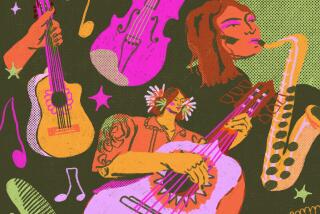Archaeologists digging up pre-Columbian sounds
- Share via
MEXICO CITY — Scientists were fascinated by the ghostly find: a human skeleton buried in an Aztec temple with a skull-shaped clay whistle in each bony hand.
But for nearly 15 years no one blew into the noisemakers. When someone finally did, the shrill, windy screech made the spine tingle.
Roberto Velazquez believes the Aztecs played this mournful wail from the so-called Whistles of Death before they were sacrificed to the gods.
The 66-year-old mechanical engineer has devoted his career to recreating the sounds of his pre-Columbian ancestors, producing hundreds of replicas of whistles, flutes and wind instruments unearthed in Mexico’s ruins.
For years, many archaeologists who uncovered ancient noisemakers dismissed them as toys. Museums relegated them to warehouses. Most studies and exhibits of ancient cultures focus on how they looked, but Velazquez said the noisemakers provide a rare clue to how they sounded.
“We’ve been looking at our ancient culture as if they were deaf and mute,” he said. “But I think all of this is tied closely to what they did, how they thought.”
Velazquez is involved in a growing field of study that includes archaeologists, musicians and historians. Medical doctors are interested, too, believing that the Aztecs may have used sound to treat illnesses.
Noisemakers made of clay, turkey feathers, sugar cane, frog skins and other materials were an integral part of pre-Columbian life, found at nearly every Maya site.
The Aztecs sounded the low, foghorn hum of conch shells at the start of ceremonies and possibly during wars to communicate strategies. Hunters may have used animal-shaped ocarinas to produce throaty grunts that lured deer.
The modern-day archaeologists who came up with the term Whistles of Death believe they were meant to help the deceased on the journey into the underworld, and tribes are said to have emitted terrifying sounds to fend off enemies, much like high-tech crowd-control devices available today.
Experts also believe pre- Columbian tribes used some of the instruments to send the human brain into a dream state and treat certain illnesses. The ancient whistles could guide research on rhythmic sounds’ effect on heart rates and states of consciousness.
Among Velazquez’s replicas are some that emit a strange cacophony at a frequency nearing the maximum range of human hearing.
Chronicles by Spanish priests from the 1500s described the Aztec and Maya sounds as sad and doleful, although these may have been only what was played in their presence.
“My experience is that at least some pre-Hispanic sounds are more destructive than positive, others are highly trance-evocative,” said Arnd Adje Both, an expert in pre-Hispanic music archaeology who was the first to blow the Whistles of Death found in the Aztec skeleton’s hands. “Surely, sounds were used in all kind of cults, such as sacrificial ones, but also in healing ceremonies.”
Sounds still play an important role in Mexican society. A cow bell announces the arrival of the garbage truck outside Mexico City homes. A trilling, tuneless flute heralds the knife sharpener’s arrival. A whistle emitting cat meows says the lottery ticket seller is here.
But pre-Columbian instruments often end up in warehouses, Velazquez said, “and I’m talking about museums around the world doing this, not just here.”
That’s changing, said Tomas Barrientos, director of the archaeology department at Del Valle University of Guatemala.
“Ten years ago, nothing was known about this,” he said. “But with the opening up of museum collections and people’s private collections, it’s an area of research that is growing in importance.”
Velazquez meticulously researches each noisemaker before replicating it. He travels across Mexico to examine newly unearthed wind instruments, some dating to 400 BC and shaped like animals or deities. He studies reliefs and scans 500-year-old Spanish chronicles.
But making replicas is only part of the work. Then he must figure out how to play them. He’ll blow into some holes and plug others, or press the instrument to his lips and flutter his tongue. Sometimes he puts the noisemaker inside his mouth and blows, fluctuating the air from his lungs.
He experimented with one frog-shaped whistle for a year before discovering its inner croak.
Renowned archaeologist Paul Healy, who made an important discovery of Maya instruments in Belize in the 1980s, said many of the originals still work.
“A couple of these instruments we found were broken, which was great because we could actually see the construction of them, the actual technology of building a sound chamber out of paper-thin clay,” he said.
Still, their exact sounds probably will remain a mystery.
“When you blow into them, you still can get notes from them, so you could figure out what the range was,” Healy said.
“But what we don’t have is sheet music to give us a more accurate picture of what it sounded like.”
More to Read
Sign up for Essential California
The most important California stories and recommendations in your inbox every morning.
You may occasionally receive promotional content from the Los Angeles Times.













